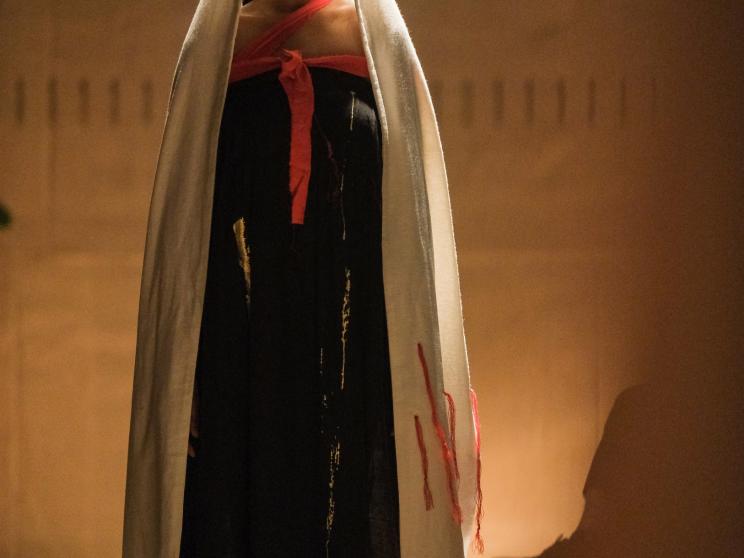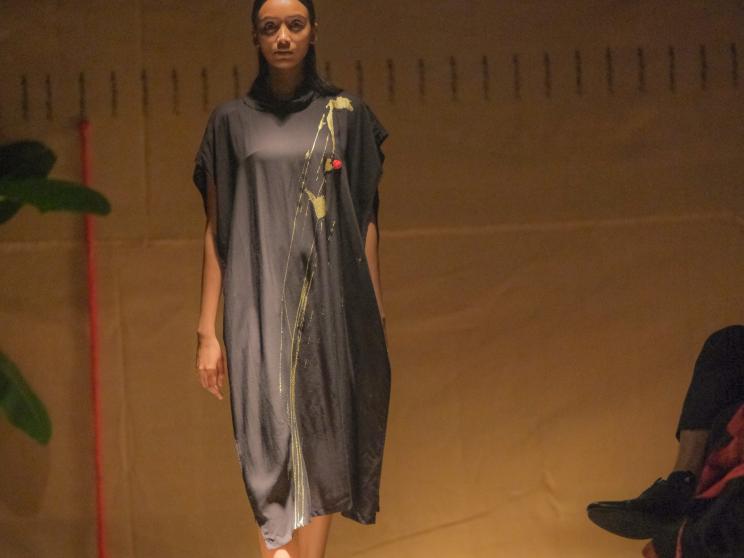Deborah Zannat on Faiza Ahmed’s fashion show, Atma Bala 0.01

On the evening of Friday, 13 October, fashion brand Manas owner Faiza Ahmed organised her first stand-alone fashion show, Atma Bala 0.01. It took place at Dhaka Gallery, the endeavour of architect Mustapha Khalid Polash in Banani.
It was an immersive experience, calling on all senses – from the taste of her exquisite vegan food buffet and the lingering smell of incense to the atmosphere of meditation produced by dim lighting and a soundscape blending singing bowls, live music, and rhythmic poetry.
When she first requested me to take part in her show, I asked myself – what do I have to do with Dhaka's fashion scene? Somehow, over the few years we have known each other, Faiza's philosophy of life has won the heart of my husband, Razon Fakir. He insisted I accept. The heart speaks a language that does not care about categories.

Faiza Ahmed is a fashion activist. Her activism uses fashion as a medium to tell stories. Stories of womanhood, of transformation – of transmutation. Her process truly is alchemy, as she digs into the darkness, the heaviness, and the rawness of her own experience to bring out light, and subtleness.
In France, we say "Créateur de Mode", fashion creator. In theology, Creation happens when the Creator breathes life into inert objects. The Creature, in the Creator's image, then takes on its freedom. The creation of life happens within the realm of perfection; the creation of art happens within the realm of incompleteness, within the human world, as a quest for completion. A quest for beauty. In the way Aristotle meant with the thought that "art imitates nature", we may call Faiza a fashion artist. As an artist, she breathes her inner world into inert matter, transmuting intellectual, emotional and spiritual energy into a narrative.
And this is where the sense of touch comes in. The economy of Bangladesh may be in a strong part built on fast fashion. But its heart, its identity, lies in slow fashion. In simple clothes worn until they are ready to be turned into nakshi kantha. In the sensations created on the skin by the traditional weaves, the roughness of jute, of khadi, the softness of tant, of mulmul muslin.
The way each traditional fabric lets the wind, the golden wind of Bangladesh, reach the skin, in sensations of warmth and cool, to the extreme of how it feels to sweat in each fabric. The sense of touch is intimately linked to the five elements of creation — wind, earth, fire, air and, as the vessel that holds project and space, ether.

Traditional Bangladeshi fabrics carry with them these five elements, in more than a sensorial experience – a sensual experience. And this is exactly where beauty lies. What is beauty? How do we relate to it, how do we embody it? How can we know it?
Fashion is, quite obviously, beyond simply covering the shame of nakedness to interact in society. There is a sociology of fashion, an ethnology of fashion. Fashion can carry a sense of belonging, as it is used to project our identity, consciously or not, on the social stage.
Fashion may be about showing off, regardless of comfort. Who feels beautiful when the fabric on her skin starts smelling bad, or itches, or is so tight it hampers her breath? Beauty in fashion is not about cuteness, it is not about prettiness. It is definitely not about outward sexiness. It isn't even about aesthetics, about harmonious lines – this is something anyone with basic training can calculate out.
Musical harmony may include off-notes, unusual or unexpected arrangements. Because the core of harmony is in centredness, in cohesiveness, in the coherence of what may otherwise remain chaotic. This is what narratives do. And this is what Faiza does as she transmutes her life narrative into fabric-based art.
It is said, that beauty is truth. And what can be truer than an absolute presence to the senses, to the world – to one's existence? What is beauty if not the confidence someone has when the clothes on her body make her feel comfortable yet present to herself, before being present to others?
What is luxury, if not the perfection of subtlety that cannot be bought with money, but rather with that beautiful, truthful presence to oneself? Only a pianist knows the difference between playing on an electric keyboard and on a grand Steinway… It is about touch, about the instinctive animality of touch, which ties us to nature, and can then be brought into culture, through the senses of intelligence which are sight, in the field of fashion, and sound, in the field of music.
As the two groups of five models walked the runway in Atma Bala 0.01, each outfit expressed a different touch, a different feel on the skin, which the viewers were invited, silently, almost subconsciously, to imagine on their own skin.
As each model carried Faiza's journey, through the loose hair, light natural make-up and slow-paced inner-gazing walk, through the perfectly positioned metaphorical rays of red threads and gold slashes on soft black, they sent us to that very moment when the creator sets their creature free.

Faiza's creations are a call to take on her embodiment of womanhood, of motherhood, of the struggles that are weaved into the patriarchy, and make her experience our own, breathe our own experience into hers, through that medium of offering, of sharing, that is fashion.
At the end of the show, a journalist asked me if, and where, I found a link between the philosophy of Lalon Sain and Faiza's work. The link is not only in or about spirituality – a category that in itself constantly needs defining.
Faiza uses a slogan for her brand Manas: "the smell of the earth". Of course, this subtitle takes us back to the struggles of motherhood in the metaphors of Bengal. But it also pulls us into the sensuality of Bengal's nature, and to the country's rural traditions.
Lalon Sain's discipline is a call to know oneself. To seek for truth within, beyond social constructions, to keep seeking for the truth of one's heart, of one's inner soil. To do this, he never implied that the senses needed to be shut off first, as opposed to the yogis. He never expected that a simple human being may be able to overcome and override by pure will and force the instincts, the senses that help us navigate the world.
Lalon Sain's discipline is about learning to use the instincts, the senses, in order to direct that raw chaotic creative impulsion into a subtle, steady pull upwards, towards the creator. This discipline is about sublimating one's existence beyond the "self". And in a very real sense, Faiza's work is an exact translation of this process into wearable items.
Manas, and Atma Bala, calls on us to use the senses and narratives of the self that are constantly pulled outwards in fashion, towards showing oneself, showing off, to turn inwards towards what is true beauty – an absolute presence to oneself beyond these narratives.
It is said that to reach the gates of heaven, one has to walk through hell. In struggle is found strength, just as light is born from darkness. The spiritual discipline then is about transmuting imperfection into perfection, lies into truth. And the creative discipline is about transmuting pain into beauty.
English philosopher Collingwood said that "nature's song is the song of innocence; art is the song of experience". And this is exactly why, at the end of the show, when we all stood in front of the audience, the viewers, or rather, the participants, I whispered in Faiza's ear: "you are not a fashion designer, you are an artist".



 For all latest news, follow The Daily Star's Google News channel.
For all latest news, follow The Daily Star's Google News channel.